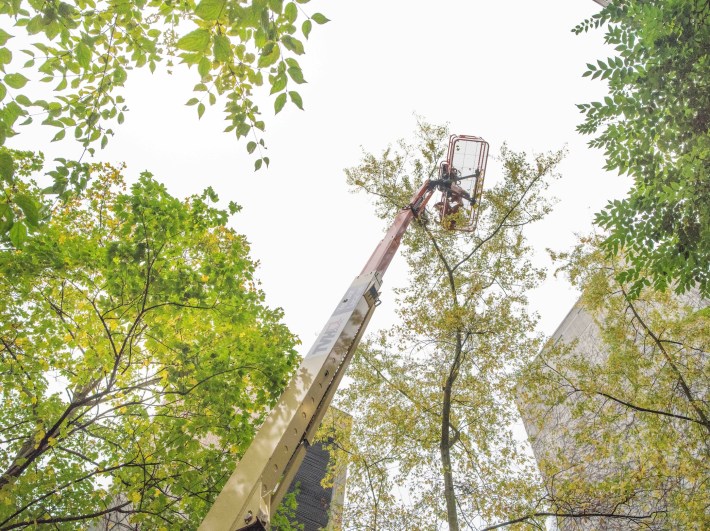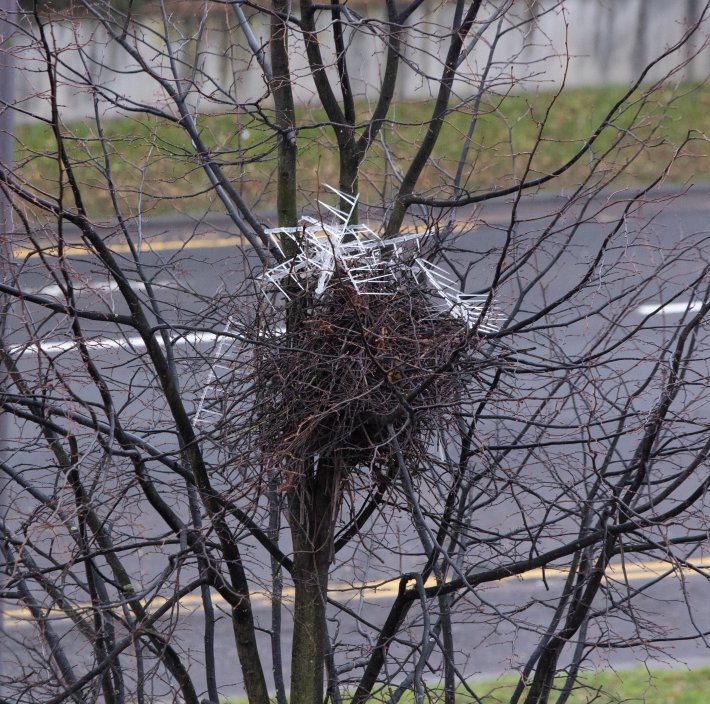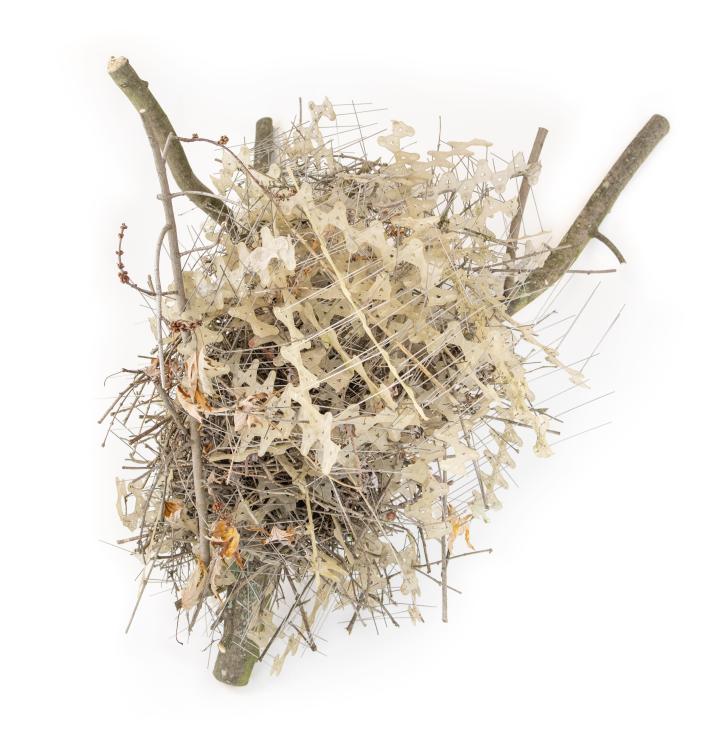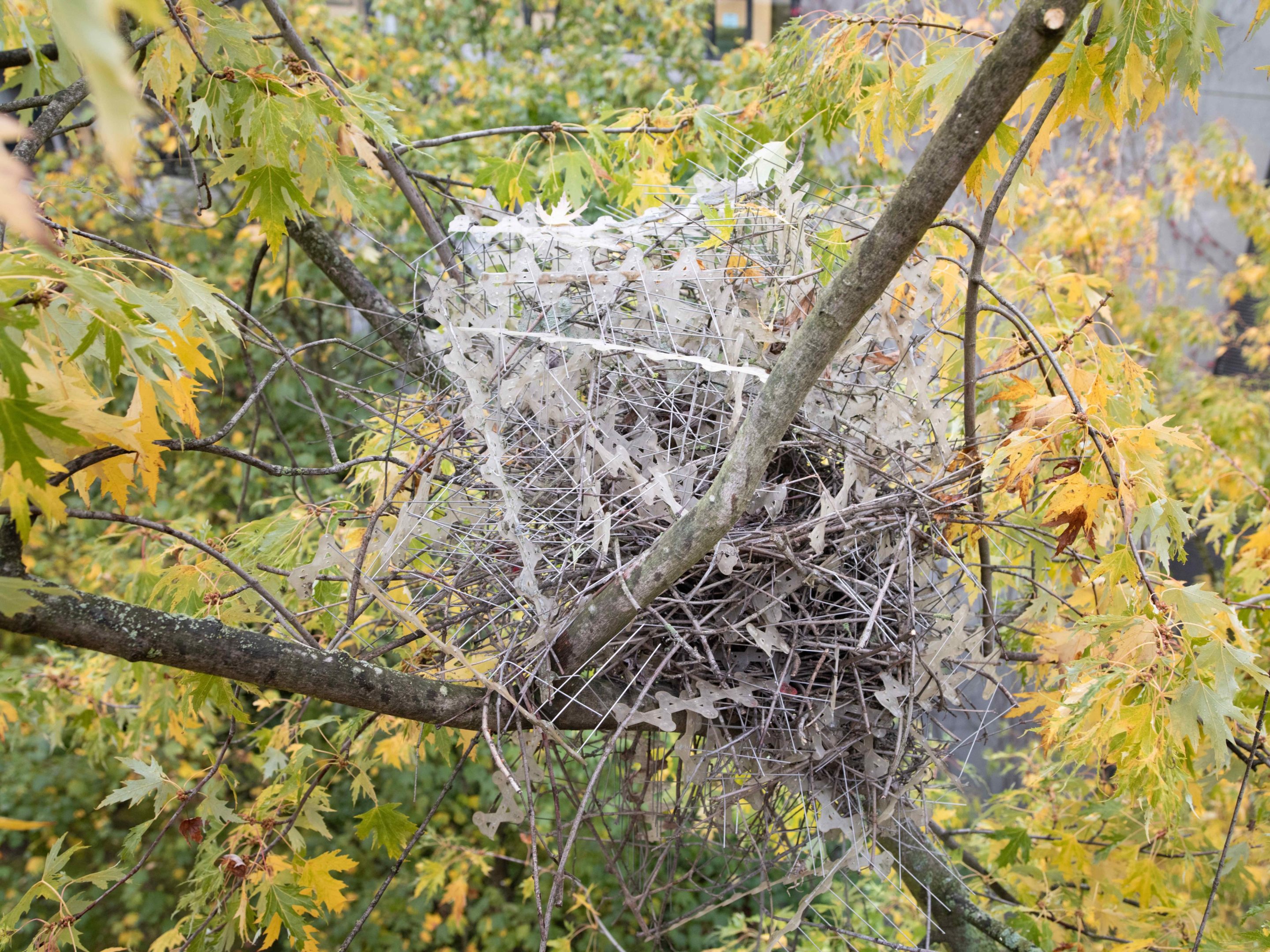Auke-Florian Hiemstra and his girlfriend Liselotte Rambonnet regularly descend into the canals crosshatching the Dutch city of Leiden to clean up trash. The canals teem with discarded bags, cups, condoms and rarer, more unforgettable plastics, like a hauntingly corroded baby doll or a dildo. Several years ago during one of these clean-ups, Hiemstra noticed a common coot, a plump black bird with a porcelain-white beak, carrying a plastic festival cup in his beak. "This bird was just in between the canals also collecting trash, just like us," Hiemstra said.
Hiemstra followed the coot as the bird swam down the canal to meet a female coot, who accepted the cup and incorporated it into her nest. "From that moment, I couldn't walk along the canals anymore without checking every bird nest for plastic," he said. Hiemstra, now a graduate student at the Naturalis Biodiversity Center in Leiden studying the ways birds nest with our trash, has seen some peculiar nests featuring windshield wipers, earphones, and a fake white carnation from Ikea's SMYCKA line. "I said, like, well, almost anything can become nest material," Hiemstra said.
As Hiemstra published his observations, he encouraged people to report any unusual nests they saw. Two years ago, he got a hot tip about a magpie nest from a patient in Antwerp, who while in his hospital bed read a magazine article about Hiemstra's work and then noticed something strange in the sugar maple outside his window. As soon as Hiemstra opened the photo, "I knew that this was going to be a crazy one," he recalled. The nest looked like a brutalist sea urchin or whatever cystic acne looks like for Pinhead from Hellraiser—a vortex of metal needles sprouting from plastic strips. The magpies had built their nest out of at least 1,500 anti-bird spikes, devices installed on rooftops and ledges to deter nesting birds. "Now I just say, well, everything can become part of a bird nest," Hiemstra said.

Last week, Hiemstra and colleagues published their observations of several crow and magpie nests built from anti-bird spikes in the journal Deinsea. They are not the first examples of birds exploiting the spikes for their own purposes; the authors of the new paper point to the infamous Parkdale Pigeon, who first built a nest on top of a LCD screen at the Parkdale Station in Melbourne. When the nest was removed a few days later and a strip of anti-bird spikes installed on top of the screen, the pigeon cushioned the needles with layers of twigs and leaves to create an even sturdier, more deluxe nest, and repeated the whole process as the nest was torn down again and again.
But corvids, a family of birds containing crows, ravens, and magpies, are notoriously smart creatures, able to use tools, solve puzzles, and even recognize human faces. Carrion crows appear to use anti-bird spikes for the structure of their nests, as the spikes point inward. And magpies, Hiemstra believes, are using the spikes for their exact purpose: to deter other birds. "This does not really surprise me," Claudia Wascher, a behavioral ecologist who has studied crows, wrote in an email about the nests.

The magpie nest in the Antwerp hospital was a feat of design, with the needles of at least 148 anti-bird strips menacing any predators who would draw near. Hiemstra waited until after the breeding season before he collecting the nest. He contacted the tree maintenance workers at the hospital and borrowed a window cleaning lift to see the construction with his own eyes, where he found himself deeply moved. "That first moment, just seeing it, I just stared," he said. "It's such a wild and strange and quirky and weird nest, but also beautiful and magical." Hiemstra trucked the nest back to the lab, suspending it from the ceiling of a large van to protect the original shape of the nest from speedbumps. Hiemstra also toured the roof of the hospital, where linear strips of glue indicated where bird spikes had been installed and, perhaps, ripped away by little black beaks.
Hiemstra began hunting for other examples of nests built from anti-bird spikes. Examples were slim in the scientific literature but bountiful on social media. He watched footage of a cockatoo tearing off anti-bird strips and learned of a crow's nest built from hundreds of strands of barbed wire housed at the Kansas Barbed Wire Museum. Unlike scientific literature, social media has no peer-review process, and one such example cited in the paper of a pigeon's nest in a sink full of discarded needles may have been staged by the Vancouver police.
But in other cases, people's love of posting helped scaffold the paper with community science. When Hiemstra saw a photo of a magpie nest in Glasgow shared by a user called @potatojunkie in December 2021, he reached out to learn more. @Potatojunkie, a photographer whose real name is Max Crawford, was at their friend's flat when they looked outside the window and saw the nest's hostile coronet of anti-bird spikes. "It took me a few seconds to realize what I was looking at, at which point I burst out laughing," Crawford said. They quickly pulled out their camera, zoomed in, and snapped a picture. Now, more than a year later, "the magpies and the spikes are both still there," Crawford said.

In total, the researchers located five anti-bird spike nests, all in larger cities. In a magpie's utopia, their nests would be located deep in the impenetrably thorny center of bushes, where anyone seeking to steal a chick would have to battle the bramble. If the birds nest in open treetops, they attempt to recreate this prickly thicket by building a dome from thorny branches, such as those from hawthorn trees—a similar defense strategy to Beanie the chihuahua's coyote-proof vest. Jukka Jokimäki, an urban ecologist studying crows at the Arctic Centre at the University of Lapland, Finland, said he has not seen this behavior in the corvids he studies in Rovaniemi, Finland. But Rovaniemi is a city of just 64,000 and not heavily urbanized. "The birds still have here a lot of natural nest building material available," Jokimäki wrote in an email.
In urbanized areas, magpies often can't find what they need."In our cities, there is almost no green," Hiemstra said. "And when there is a garden, people are more likely to plant some nice flowers than some thorny branches." Hiemstra suggests the magpies have directly replaced hawthorn branches with anti-bird strips, perhaps resulting in an even more ironclad defense. But more experiments and observations would be needed to prove this, Zuzanna Jagiełło, an ecologist at the University of Warsaw who was not involved with the research, told Science News.

When Hiemstra tweeted about the new paper, the nests went viral, thanks to the sheer irony of their construction—the latest incident in a summer of uprisings, human and animal. Headlines called the birds "rebellious" and declared their nests a perfect act of "revenge." The nests are, literally and metaphorically, extremely metal, a prickly middle finger to the hostile architecture that keeps them from roosting in our cities.
Even though Hiemstra knows the corvids are simply using the materials around them, not intentionally enacting revenge, he can't help but root for the birds. In the two years he's spent studying anti-bird spikes, he now sees them everywhere. "If you see how many bird spikes are out there, it's actually nice to see some of the birds fighting back," he said. "I think it's such an old-fashioned way to look at a city and see it as a place built by humans and only for humans. Hiemstra has even seen anti-bird spikes studding the branches of trees that droop over expensive cars. "If birds aren't even allowed in trees anymore, where are we going?" he asked.
The Antwerp nest is now on display to the public at the Natural History Museum Rotterdam. "Labeling things as art is a very human way to look at things," Hiemstra said. "But still, it's something so beautiful that for me, at least, this comes very close to what I call art." Even if the nest was not created with artistic or emotional intent, it may still function as art—moving visitors to consider what hostile structures they can dismantle and reshape into something welcoming to life. "I just wish that I could tell the magpies, like, you have no idea how famous your nest has become," Hiemstra said.






